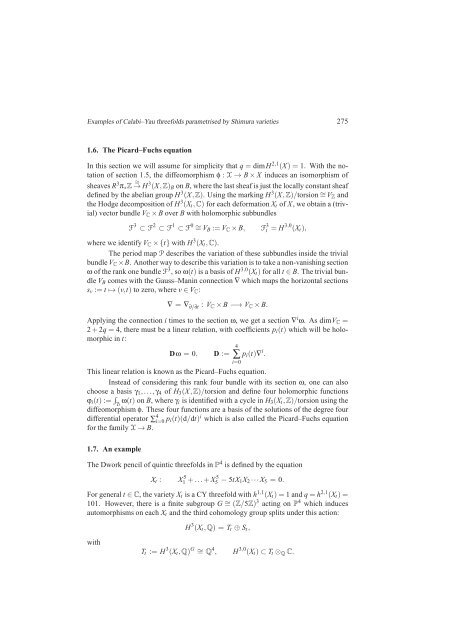Examples of Calabi-Yau threefolds parametrised by Shimura varieties
Examples of Calabi-Yau threefolds parametrised by Shimura varieties
Examples of Calabi-Yau threefolds parametrised by Shimura varieties
Create successful ePaper yourself
Turn your PDF publications into a flip-book with our unique Google optimized e-Paper software.
<strong>Examples</strong> <strong>of</strong> <strong>Calabi</strong>–<strong>Yau</strong> <strong>threefolds</strong> <strong>parametrised</strong> <strong>by</strong> <strong>Shimura</strong> <strong>varieties</strong> 2751.6. The Picard–Fuchs equationIn this section we will assume for simplicity that q=dimH 2,1 (X) = 1. With the notation<strong>of</strong> section 1.5, the diffeomorphism φ : X → B×X induces an isomorphism <strong>of</strong>sheaves R 3 π ∗ Z ∼ = → H 3 (X,Z) B on B, where the last sheaf is just the locally constant sheafdefined <strong>by</strong> the abelian group H 3 (X,Z). Using the marking H 3 (X,Z)/torsion ∼ = V Z andthe Hodge decomposition <strong>of</strong> H 3 (X t ,C) for each deformation X t <strong>of</strong> X, we obtain a (trivial)vector bundle V C × B over B with holomorphic subbundlesF 3 ⊂ F 2 ⊂ F 1 ⊂F 0 ∼ = VB := V C × B, F 3 t = H 3,0 (X t ),where we identify V C ×{t} with H 3 (X t ,C).The period map P describes the variation <strong>of</strong> these subbundles inside the trivialbundle V C ×B. Another way to describe this variation is to take a non-vanishing sectionω <strong>of</strong> the rank one bundleF 3 , so ω(t) is a basis <strong>of</strong> H 3,0 (X t ) for all t ∈ B. The trivial bundleV B comes with the Gauss–Manin connection ∇ which maps the horizontal sectionss v := t ↦→(v,t) to zero, where v∈ V C :∇ = ∇ ∂/∂t : V C × B −→ V C × B.Applying the connection i times to the section ω, we get a section ∇ i ω. As dimV C =2+2q=4, there must be a linear relation, with coefficients p i (t) which will be holomorphicin t:Dω = 0, D :=4∑i=0p i (t)∇ i .This linear relation is known as the Picard–Fuchs equation.Instead <strong>of</strong> considering this rank four bundle with its section ω, one can alsochoose a basis γ 1 ,...,γ 4 <strong>of</strong> H 3 (X,Z)/torsion and define four holomorphic functionsϕ i (t) := ∫ γ iω(t) on B, where γ i is identified with a cycle in H 3 (X t ,Z)/torsion using thediffeomorphism φ. These four functions are a basis <strong>of</strong> the solutions <strong>of</strong> the degree fourdifferential operator ∑ 4 i=0 p i(t)(d/dt) i which is also called the Picard–Fuchs equationfor the familyX→B.1.7. An exampleThe Dwork pencil <strong>of</strong> quintic <strong>threefolds</strong> in P 4 is defined <strong>by</strong> the equationX t : X 5 1 +...+ X 5 5 − 5tX 1X 2···X 5 = 0.For general t ∈C, the variety X t is a CY threefold with h 1,1 (X t )=1and q=h 2,1 (X t )=101. However, there is a finite subgroup G ∼ = (Z/5Z) 3 acting on P 4 which inducesautomorphisms on each X t and the third cohomology group splits under this action:H 3 (X t ,Q) = T t ⊕ S t ,withT t := H 3 (X t ,Q) G ∼ = Q 4 , H 3,0 (X t )⊂T t ⊗ Q C.














